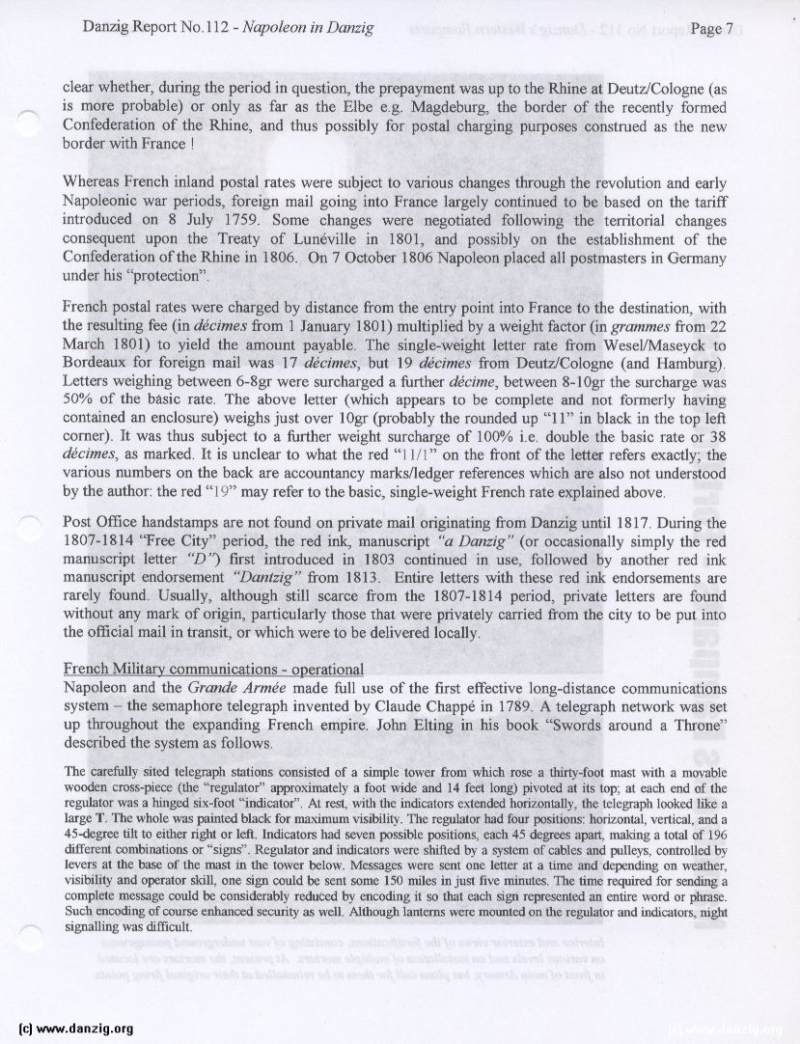
clear whether, during the period in question, the prepayment was up to the Rhine at DeutzfCologne (as is more probable) or only as far as the Elbe e.g. Magdeburg, the border of the recently formed Confederation of the Rhine, and thus possibly for postal charging purposes construed as the new border with France!
Whereas French inland postal rates were subject to various changes through the revolution and early Napoleonic war periods, foreign mail going into France largely continued to be based on the tariff introduced on 8 July 1759. Some changes were negotiated following the territorial changes consequent upon the Treaty of Lunéville in 1801, and possibly on the establishment of the Confederation of the Rhine in 1806. On 7 October 1806 Napoleon placed all postmasters in Germany under his “protection”.
French postal rates were charged by distance from the entry point into France to the destination, with the resulting fee (in décirnes from 1 January 1801) multiplied by a weight factor (in grwnmes from 22 March 1801) to yield the amount payable The single-weight letter rate from Wesel/Maseyck to Bordeaux for foreign mail was 17 décimes, but 19 décimes from DeutzfCologne (and 1lamburg), Letters weighing between 6-8gr were surcharged a further décime between 8- lOgr the ircharge was 50% of the basic rate. The above letter (which appears to be complete and riot formerly having contained an enclosure) weighs just over IOgr (probably the rounded up “11” in black in the top lefi corner). It was thus subject to a further weight surcharge of 1 00% i.e. double the basic rate o 38 décimes, as marked. It is unclear to what the red “I I/I” on the front of the letter refers exactly; the various numbers on the back are accountancy marks/ledger references which are also not understood by the author the red “19” may refer to the basic, single-weight French rate explained above,
Post Office handstamps arc not found on private mail originating from Danzig until 1817. During the 1807.1814 “Free City” period, the red ink, manuscript ‘a I)anzig” (or occasionally simply the red manuscript letter “D”) first introduced in 1803 continued in use, followed by another red ink manuscript endorsement “Danizig” from 1813. Entire letters with these red ink endorsements are rarely found Usually, although still scarce from the 1807-1814 period, private letters are found without any mark of origin, particularly those that were privately carried from the city to be put into the official mail in transit, or which were to be delivered locally.
French_Military communications - Operational
Napoleon and the Grande Armée made full use of the first effective long-distance communications system - the semaphore tdegraph invented by Claude Chappe in 1789 A telegraph network was set up throughout the expanding French empire. John Elting in his book “Swords around a Throne” described the system as follows,
The carefully sited telegraph stations consisted of a simple tower liom which rose a thirty-fool mast with a movable wooden cross-piece (the “regulator” approumaielv a foot wide and 14 feet long) pivoted at its top at each end of the regulator was a hinged six-foot “indicator”, Al ICR with the indicators extcndcd honronially, the telegraph looked like a large T. Thc whole was painted black for maunuin isibdiy. Thc regulator had four positions horizontal, vertical, and a 45-degree tilt to either right or tell Indicators had seven possible positions, each 45 degrees apart. making a total of 1% different conthinations or “signs”. Regulator and indicators were shifted by a system of cthles and pillevs. controlled by levers at the Ixsc of the mast in the tower below Messages were sent one letter at a time and depending on weather, visibility and operator skill, one gn could be sent some 150 miles in just five minutes. The time required ftw sending a complete message could be considerably reduced b encoding it so that each sign rqicscnicd an entire word or phrase. Such cncoding of course enhanced security a.s well Although lanterns mc mounted on the regulator and indicators, night signalling was difficult.
Danzig Report Vol. 1 - Nr. 112 - July - August - September - 2001, Page 7.
Hits: 3055
Added: 30/07/2015
Copyright: 2024 Danzig.org

